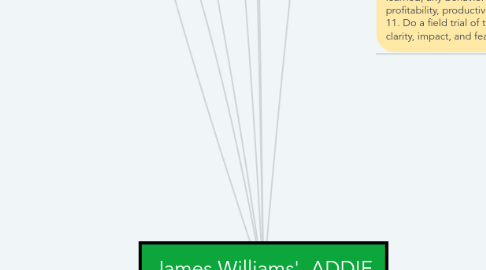James Williams' ADDIE Process
James Wにより

1. Action Steps: 1. Utilize formative evaluation by the ID constantly reflecting on the process of creating the training, its structure, and contents, and adjusting them throughout all prior stages of the ADDIE model. 2. Formative evaluation may also include attaining and acting on feedback from sponsors, stakeholders, SMEs, colleagues in the learning department, and people who test the prototype. 3. Utilize summative forms of evaluation to measure: the students' reaction to training, what they learned, and to measure any differences to their skills, knowledge, and attitudes for each objective. 4. Read students' feedback, attain sponsors' / SME / Stakeholders' feedback, and analyze how the training can be updated for the next time that it will be delivered.
2. Brief Description: A formative (ongoing) evaluation is conducted throughout the ADDIE process, in addition to a Summative evaluation of learners' learning, behavior changes, and the results of the training.
3. Brief Description: In this 3rd phase, the ID uses the information from the previous stages to create a sample of the course, which is then expanded so that the whole course is developed, and a run-through (test) is performed and feedback garnered and integrated.
4. Brief Description (of Analysis): The ID (Instructional Designer) gathers information, identifies pre-existing knowledge, and knowledge gaps, analyzes the problem, and clarifies the training's objectives, goals, and the desired employee / student outputs.
5. 1. ANALYZE
5.1. Action Steps: In an in-person, or virtual meeting(s), ask the stakeholders / Subject Matter Expert (SME): 1. the purpose of the training. Is training the right solution? 2. the training outcomes and tasks learners will have to perform back on the job. 3. who is the training audience? 4. what constraints are there, including time, money, location, SME availability, employee travel, and resources? 5. What is the learners' present role, what are their responsibilities, and what environments do they work in? 6. How will the stakeholder / SME evaluate the effectiveness of the training? Then: 7. Perform an instructional analysis and hierarchically determine the major outcomes, tasks, subtasks, activities and steps to lead to those outcomes. If skills aren't being taught, and only knowledge, then perform a content analysis. 8. With the SME / stakeholder, hierarchically analyze the procedures, principles, facts and concepts that learners must understand to perform the activities, tasks and subtasks mentioned in the analysis. Arrange them in a logical sequence. 9 To perform a content analysis, identify what learners must know to be able to successfully complete each part of the course.
6. 3. DEVELOP
7. 4. IMPLEMENT
7.1. Brief Description: To implement the training, the instructors need training or briefing, the learners may need preparatory information or tools to begin the training, and the learning space must be prepared. The training is also delivered during this phase of the ADDIE model.
7.2. Action Steps: 1. Train or brief the instructors who will deliver classroom training on: the objectives, activities, media and technology to be used, and the assessments. 2. Ensure the learners are prepared by checking that they have the necessary equipment, web-portal access and hardware, and any preliminary knowledge needed to take the training. 3. Identify all resources that will be needed in the learning environment, and ensure they are available, when needed, at the location. 4. Deliver the training. 5. Collect students' feedback.
8. 5. EVALUATE
9. Brief Description: ADDIE is an instructional design model describing a process that can be used to plan, analyze, create, test, evaluate, and update engaging, efficient, and effective training content. The 5 phases of the process are numbered above, are briefly described, and each consists of a series of action steps.
10. Action Steps: 1. Create the look and feel of the user interface / course navigation tools. 2. Create a working prototype if training is to be delivered online. If the training is offline, create a page or slide template. 3. Create a style-guide so that the designer knows what writing standards and visual standards to use. 4. Formalize the training design by creating a blueprint or instructional design document detailing how the training is to be: structured, developed, and presented. 5. Design a feedback document for testing the prototype. Ask about the training's clarity, its impact, and its feasibility for the test learner. 6. Test the prototype with single users from the target audience, or with a small group. 7. Integrate helpful feedback from testers. 8. Present prototype module to stakeholders and note their feedback. 9. Integrate stakeholders' feedback. 10. Design the summative evaluation to measure the students' reaction to training, what they learned, any behavior change, the results (e.g. profitability, productivity, and job satisfaction) 11. Do a field trial of the training, assessing for clarity, impact, and feasibility.
11. 2. DESIGN
11.1. Brief Description: The ID chooses a course format, structure, sequence, and systematically designs lessons, assessments and exercises. The course length is determined, and she/he identifies the specific media to be used.
11.2. Action Steps: 1. Using the information already gathered, decide on the instructional modules, units, topics, and the lessons. Group content for which there is little information. 2. Sequence the modules, unites, topics, and lessons. 3. Write the objectives for each part of the course describing what students will perform after doing each course module, unit, topic, or lesson. 4. Identify the type of practice exercises and activities necessary to bring students' knowledge to levels needed to fulfill objectives and outcomes, e.g. quizzes, demonstrations, teaching others. 5. Decide where to place each activity in the course, and what sequence to put it in. 6. Decide whether some content needs to be taught upfront. 7. Select a delivery system (or blend systems), e.g. web-based training, on-the-job training, classroom instruction, web lectures, web conferences, or self-study books, manuals, and job aids.


